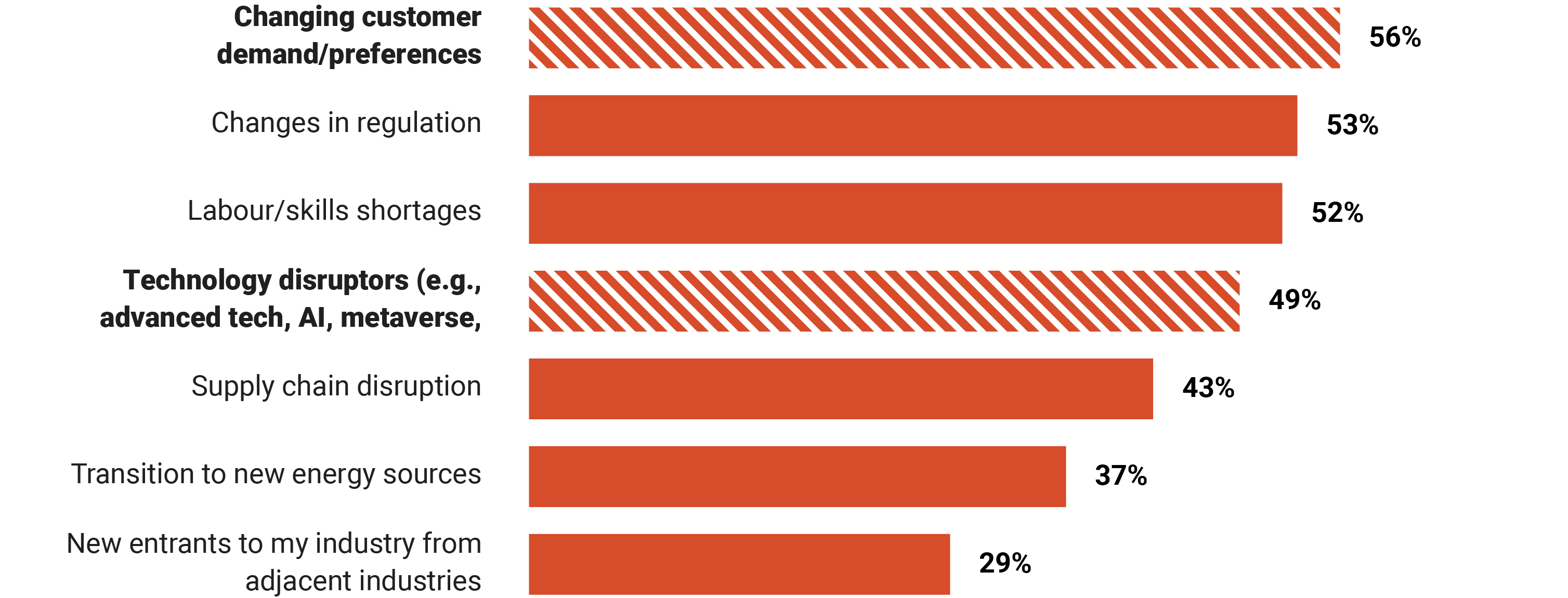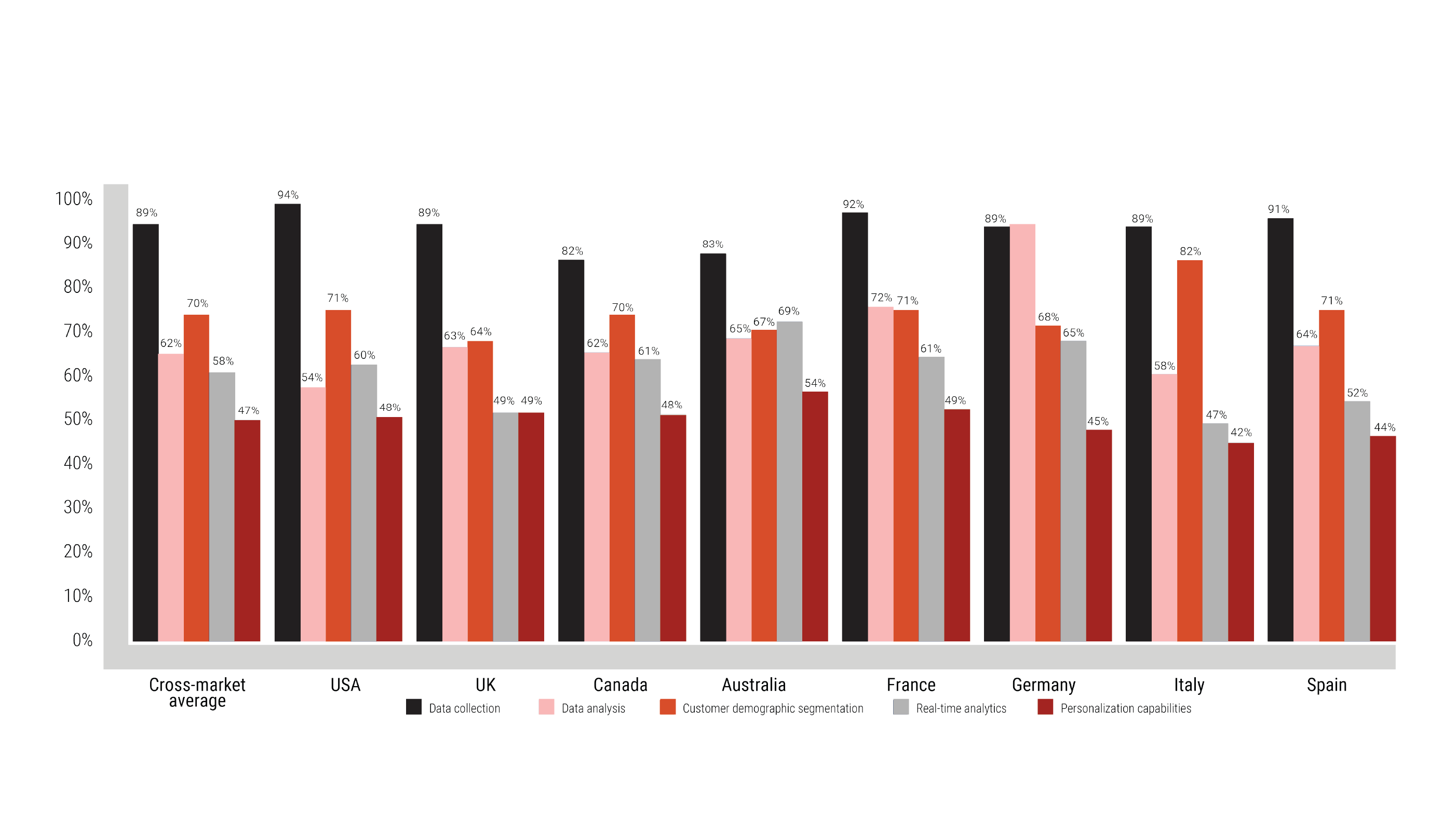Download the PDF version

Customer experience management has evolved dramatically in recent years. Enterprise clients used to select third-party outsourcers because they offered to handle customer care more cheaply than the service could be done in-house. It was “your mess for less.”
In today’s market, customers expect more. If businesses continue operating as they once did, many face obsolescence. According to a recent survey of 4,410 CEOs around the world conducted by the professional services firm PwC, 40% said their “business will no longer be viable in ten years if it continues on its current course.”
What Global CEOs See as the Greatest Challenges to their Businesses in the Next Decade
Changes in customer preferences and technology disruptors promise to upend businesses if they do not embrace change.

The key to success, or even survival for many enterprises, is reinvention through digital transformation. The process of digital transformation can be expensive though. Businesses worldwide are forecast to spend $2.8 trillion on such initiatives by 2025. And not all technologies promise the same return on investment.
Above all, three technologies stand to deliver the most significant benefits to enterprise clients and consumers: analytics, robotic process automation, and artificial intelligence.

The Trifecta of CX Technology for Digital Transformation
Data has always been a vital means of measuring the health of business operations, including costs, revenue, and productivity. Yet, its importance has increased due to the proliferation of digital data. Data is generated by interactions when consumers reach out to customer support, or from page views online, among other sources. Frequently, third parties sell or share data. Analytics can harness this data to deliver a wealth of insights.
1. Analytics personalizes CX.
Often customers consent to their data being collected online for this very reason: they expect brands to use that data to offer a more highly personalized experience. This includes customized product offerings, relevant suggestions on new offerings, and suitable product alternatives. Increasingly, this is the fundamental difference between businesses that have undergone transformation and digital laggards. For online businesses “personalized customer experiences have unequivocally become the basis for competitive advantage,” the Harvard Business Review recently noted.
Analytics also offers predictive insights on spending and consumption patterns, informing future trends. New designer fashions; weather impacts; seasonal and holiday peaks: analytics can capture these and a host of other consumer patterns. Given the power to accurately forecast growth, the market for predictive analytics is expected to surpass $41.5 billion over the next five years.
CX Analytics Platforms
While in-house analytics adoption is strong in many demand markets, US-based companies are more likely to still lack data analysis and personalization capabilities.

Still, enterprises can have trouble digesting the vast amounts of information at their disposal. Academics and business leaders alike are wrestling with what’s become known as “the data deluge.” At a basic level, data must be captured, organized, and put into structures that form relevant pools for making informed decisions.
“Everyone is trying to get data–whether through social media, the voice channel or customer channels,” says Alfredo Antonio, Senior Vice President of Global Sales and Customer Success at Inspiro, a reality that he acknowledges “can be cumbersome” for many enterprises. For this reason, many brands find that partnering with a third-party service provider allows easier access to properly structured data. Well-defined and structured data facilitates actionable insights.

2. Robotic process automation (RPA) automates routine inquiries.
RPA is another critical component of digital transformation that promises lasting benefits for enterprises and customers. RPA relies on software ‘bots’ or ‘chatbots’ to automate routine CX interactions. Based on a given request, bots can cancel reservations, reset passwords, or fill in forms, and then automatically generate post-contact follow-ups.
Across this range of tasks, RPA helps enterprises improve the accuracy of customer data. As bot usage has grown, its functionality has increased. Today, ‘attended RPA’ works to assist agents by populating information boxes on the agent’s desktop. Meanwhile, ‘unattended RPA’ functions autonomously to handle consumer inquiries, freeing the agent to direct their energy toward more emotionally involved and complicated interactions.
By one account, 79% of employers noticed a reduction in errors after introducing RPA.7 For enterprises, long-run costs are reduced because agents are no longer needed for routine CX tasks. Bots not only record data from consumers, but they can securely transfer it, ensuring higher levels of compliance with privacy regulations and a lower risk of data breaches. Operations thus become more secure.
Based on these benefits, RPA spending has been the highest of any category in enterprise software in recent years. That pace of spending is expected to slow by the mid-2020s, by which time most enterprises will have already invested heavily in RPA. But for those companies that lack it, RPA remains the key bedrock of any effort to realize the efficiency potential promised by digital transformation.

3. AI couples data with improved customer interactions.
While RPA automates frequent inquiries, AI can offer additional benefits. Built on machine learning, AI generates data and eases its transfer across channels.
One area where AI’s benefits are most evident in contact centers is through improved digital voice capabilities. The precursor technology, integrated voice recognition (IVR), traces back to the era when CX relied heavily on calls. IVR software offered pre-programmed responses to common inquiries. With AI though, “virtual agents” can provide highly responsive conversations based on customer needs, resolving more complex inquiries. For example, once a virtual agent engages with a caller, it offers a greeting and identifies the concern. It can then go further, diagnosing the specific issue within a multi-item order.
Alternatively, if a customer begins their interaction with chat or social media, AI-powered virtual agents can offer detailed responses on a host of topics. This amounts to a significant improvement for customers, who used to encounter bots that could address along a single line of inquiry but that struggled to offer help on different topics or satisfy additional customer needs. Nowadays, AI ensures chat or social media inquiries receive specific item and order information, recommendations with relevant web links, and near instantaneous translation to facilitate multilingual support.
On many occasions, the customer’s concern is satisfactorily resolved at this stage. However, if matters remain unresolved, the virtual agent can handoff to a human agent. At this point, the virtual agent has collected valuable information on the problem. The virtual agent has also gauged the customer’s sentiment given the use of phrases, intonation and other sentiment indicators, based on natural language processing (NLP). Such patterns in communication offer rich detail as the virtual agent routes the customer to a live agent.
In this way, AI enhances the agent’s understanding of a caller’s issue. The agent is poised to offer a satisfying resolution. “When a customer who engaged with an AI or digital agent is transferred to a human agent, there should be this level of empathy or awareness from the human agent,” says Rommel Regino, Chief Operations & Sales Officer at Inspiro. He goes on to explain that empathy positions the agent “to recognize whether or not the customer was comfortable during their interaction with the virtual agent or even with the handoff.”
The human agent can then attend more directly to the caller with a response that reflects the emotional needs and critical issues required to address the issue. The primary result: an increased likelihood of one-call resolution, satisfying the customer and improving the overall CX. Beyond that, the agent could also gauge “whether it’s okay to cross-sell or upsell, given the state of a particular customer,” Regino says.
Achieving Seamless Integration
Analytics, RPA and AI vow a dramatic return on investment for clients. Still, these digital bells and whistles do not magically incorporate themselves into enterprises’ operations. If the enterprise is a startup, it may be able to move rapidly into a cloud-based platform. In a cloud platform, seamless data flows can be widely accessed by employees, bestowing immediate and comprehensive snapshots that allow for timely and accurate interactions.
Often though, careful integration with legacy platforms is required. Venerated companies and those with a large global footprint may possess in-house platforms as well as IT systems located abroad. In this context, trying to force a multi-channel technology onto existing platforms can generate lurches. Agents may be unable to help customers because they cannot see all the customer’s information; data may be stored out of the agent’s view. Or, an enterprise technology may offer key features for a certain customer service channel, while others may excel when deployed over different channels.
Accordingly, compelling reasons exist for using a mix of enterprise technologies. Strong offerings from new IT providers come onto the market frequently. At the same time, tried-and-true platforms exist for bundled voice, email and chat, for instance. Given this, “the best approach should be technology agnostic,” explains Alfredo Antonio at Inspiro, “as a customer you want the choice: the ability to choose based on what is the best-of-breed approach per channel and per platform.”

“In every interaction, the first call resolution concept has to be in mind—always. A customer is triggered when they are told things like “we’ll call you back.” So, there should always be a high first contact resolution. The higher the first contact resolution, the less friction.”
Rommel Regino
Chief Operations & Sales Officer, Inspiro
Regardless of the configuration, the result should be CX that engages consumers without snags. AI-powered virtual agents should offer compelling responses to a gamut of scenarios. But if interactions are not resolved, virtual agents must empower human agents to work more quickly and effectively on a customer’s issue, all without the need for a customer to push buttons or repeat the request. Therein lies the chief benefit of digital transformation: using technology to empower agents to deliver frictionless engagement.
Conclusions
A digital transformation strategy built around analytics, RPA and AI promises significant benefits in improving the customer experience. Companies gather a better understanding of consumer preferences and buying patterns with analytics, a benefit that customers themselves also enjoy as they seek tailored shopping experiences. Meanwhile, RPA ‘bots’ streamline an array of routine tasks, saving time and allowing agents to focus their energy on more complex customer interactions. AI delivers yet greater benefits for companies, ranging from faster response times to consumer inquiries to more fluid and seamless interactions.
These technologies promise benefits not only for enterprises and consumers but employees as well. Employee satisfaction can be gauged through surveys, frequency of contacts with supervisors, and productivity metrics. Using analytics to accumulate such data is important to ensuring positive work conditions, avoiding high employee turnover, and “quiet quitting.” In tandem, RPA and intelligent automation serve to focus employee energy away from tedium and toward interactions that are unique and demand critical thinking skills. Employees thus feel empowered to focus on meaningful activities. In this way, these technologies enhance the employee experience (EX)—and high EX is a direct corollary to better CX.




